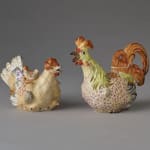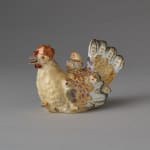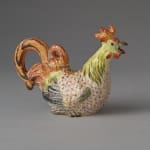


A Pair of Rare Meissen Teapots and Covers in the Form of a Cockerel and Hen, Circa 1758-60
Hen: Height: 4 1/2 ins. (11.4 cms.) Length 7 ins. (17.8 cms.) Width: 3 1/2 ins. (8.9 cms.)
Further images
A Pair of Rare Meissen Teapots and Covers in the Form of a Cockerel and Hen, modelled by J.J. Kaendler. The cockerel, seated alert, cranes its neck painted golden with brown tinged plumage. Captured crowing, its gaping beak and wide eyes are further enhanced by the vigour of its iron-red wattles and flame coloured comb, to form the end of the spout. Along its body, relief moulded tawny feathers are patterned in variegated bands of puce, orange, and black flecks, blending into longer breast feathers in black and grey. The flame coloured tail forms the handle and incorporates the cover.
The hen is modelled with nine chicks emerging from its feathers, including one on her back preening itself to form the finial of the cover. The hen’s head forms the end of the spout, with beak open as it glances down at its chicks. The plumage is naturalistically painted in tawny tones flecked with black and enhanced by puce and amber banded feathers. The tail forming the handle stands alert.
Zoomorphic teapots of this nature were first modelled in Chinese porcelain which Kaendler adapted into his models.
Marks: Underglaze blue crossed swords to the base of each teapot
Further Details: Teapots of these rare animal forms are first mentioned by Kaendler in 1734: ‘’1 Thee Pot in Gestalt einer alten Henne, aber von mittelmäßiger Größe, welche 9 Junge bei sich hat und solche behütet. Oben auf dem Huhn sitzt ein Junges, welches den Deckel zum Mundloch bedeutet, Zum Schnabel der Henne läuft der Thee raus.’ [1 teapot in the form of an old hen, but of middling size, which has 9 chicks with it that it shelters. A chick is seated on top of the hen, which forms the cover to the opening, the tea pours from the hen’s beak]’. Similar teapots in the form of a hen are in the historic collection in Schloss Friedenstein, Gotha, and in Schloss Lustheim, Meissener Porzellan-Sammlung, Stiftung Ernst Schneider. Similar examples of a teapot in the form of a cockerel are published in Maureen Cassidy-Geiger The Arnhold Collection of Meissen Porcelain 1710-50 (New York: The Frick Collection, 2008), 365, pl. 133. See also Ulrich Pietsch Passion for Meissen: The Said and Roswitha Marouf Collection (Stuttgart: Arnoldsche, 2010). 279-281, pl. 138. See an example in the Manchester Art Gallery (1984.753)
Provenance
Private European CollectionJoin our mailing list
* denotes required fields
We will process the personal data you have supplied in accordance with our privacy policy (available on request). You can unsubscribe or change your preferences at any time by clicking the link in our emails.


